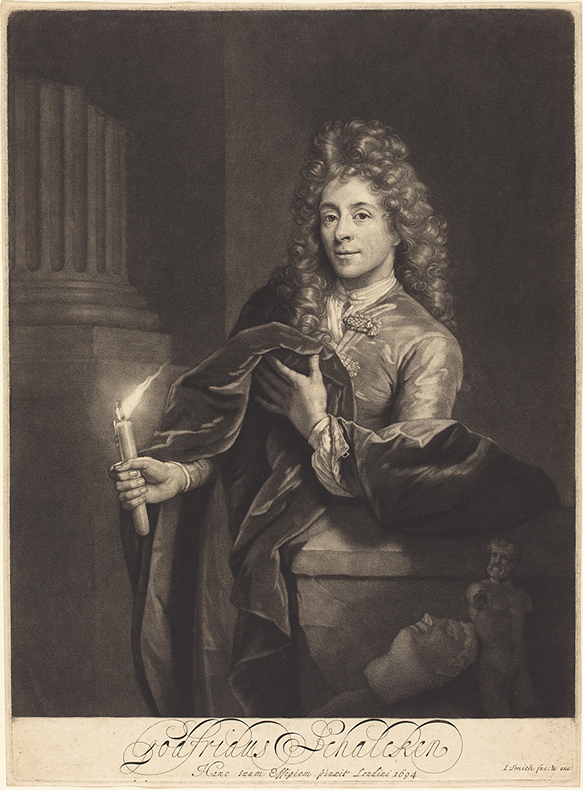Works of Art
- Filters:
- Sort by:
- Results layout:

Dutch, 1643 - 1706
Schalcken, Godfried; Schalcken, Gottfried; Schalken, Gottfried
Copy-and-paste citation text:
Lara Yeager-Crasselt, Arthur K. Wheelock Jr., “Godefridus Schalcken,” NGA Online Editions, https://purl.org/nga/collection/constituent/25817 (accessed April 15, 2025).
Export as PDF
Godefridus Schalcken was born in Made, a town south of Dordrecht, where his father, Cornelis Schalcken, was a minister. Schalcken’s father and his mother, Aletta Lydius, moved their family to Dordrecht in 1654 when Cornelis was appointed principal of the Latin school.[1] Between 1656 and 1662 Schalcken was apprenticed to the artist and theorist
Schalcken’s biographer, Arnold Houbraken, who probably knew the artist personally, admiringly described him as one of the few who made a good living from his painting.[3] In 1691 Schalcken paid dues amounting to eighteen guilders to The Hague painters’ guild, Pictura, which gave him the right to sell his work in the city without actually living there.[4] In 1692, however, Schalcken and his wife left the Netherlands for England.[5] According to Houbraken, the English had lured Schalcken to their country, where he was able to earn his fortune.[6] The couple resided at Windsor, at the court of William III, where Schalcken painted the king’s portrait as well as the portraits of other English aristocrats. By 1699 Schalcken had returned to the Netherlands and settled in The Hague. Except for a period of work in Düsseldorf (1701) at the court of Johann Wilhelm, the Elector Palatine, he remained in The Hague for the rest of his life. He died November 13, 1706, at the age of sixty-three.
Schalcken is known primarily for his delicate night scenes, which he painted in the style of his master, Dou. He also painted portraits, as well as genre scenes and biblical and mythological subjects. Not much is known about his working methods, although Walpole describes how Schalcken “placed the object and a candle in a dark room, and looking through a small hole, painted by day-light what he saw in the dark chamber.”[7] Schalcken had several pupils, among them his sister Maria (b. c. 1647–1650), his cousin Jacobus Schalcken (c. 1683/1686–1733), Anthony Vreem (1660–1681), Arnold Boonen (1669–1729), Simon Germijn (b. 1650), Karel de Moor (1655–1738), and Rachel Ruys (1664–1750).
[1] Thierry Beherman, Godfried Schalcken (Paris, 1988), 23–29, and G. H. Veth, “Aanteekeningen omtrent eenige Dordrechtse schilders,” Oud-Holland 10 (1892): 1–16.
[2] Matthys van Balen, Beschryvinge der stad Dordrecht… (Dordrecht, 1677), 688. In his extensive article on Schalcken, G. H. Veth, probably by mistake, writes that Schalcken was back in Dordrecht by 1665 because in that year he was was the standard bearer for the 7th Company Dordrecht Civic Guard (G. H. Veth, “Aanteekeningen omtrent eenige Dordrechtse schilders,” Oud-Holland 10 [1892]: 2, note 5). However, Van Balen dates Schalcken’s role as standard bearer to 1675. It is, nevertheless, probable that Schalcken returned to Dordrecht by the mid-1660s (information kindly provided by Guido Jansen).
[3] Arnold Houbraken, De Groote Schouburgh der Nederlantsche Konstschilders en Schilderessen. 3 vols. (The Hague, 1753; reprint: Amsterdam, 1976), 3:176: “aangezien zyne penceelkonst van den beginne af tot het einde van zyn leven rykelyk betaald wierd, zoo dat hy de vrichten van zyn arbeyd by zyn leven gemaait heeft, dat zeer weinigen gebeurt.”
[4] Abraham Bredius, “De Boeken der Haagsche schildersconfrerie,” in Frederik Daniel Otto Obreen, ed., Archief voor Nederlandsche Kunstgeschiedenis 5 (1882–1883): 138. For the painters’ guild Pictura see: Johan Gram, De Schildersconfrerie Pictura (The Hague, 1882). According to rule 2, painters from outside The Hague could join for eighteen guilders in order to sell their work in that city (pp. 12 and 19).
[5] According to Walpole and Vertue, Schalcken made two trips to England before settling there. See Horace Walpole, Anecdotes of Painting in England with Some Account of the Principal Artists; and Incidental Notes on Other Arts; Collected by the Late Mr. George Vertue, 5 vols. (London, 1826–1828), 3:264; and George Vertue, Notebooks 1, [V.7, B.M. 9], in Walpole Society 18 (1929–1930): 29.
[6] Arnold Houbraken, De Groote Schouburgh der Nederlantsche Konstschilders en Schilderessen. 3 vols. (The Hague, 1753; reprint: Amsterdam, 1976), 3:176. “toen de Engelsen . . . hem in hun land lokten, daar hy verscheiden jaren gewoont en veel geld vergaart heeft.”
[7] Horace Walpole, Anecdotes of Painting in England with Some Account of the Principal Artists; and Incidental Notes on Other Arts; Collected by the Late Mr. George Vertue, 5 vols. (London, 1826–1828), 3:263.
Arthur K. Wheelock Jr.,
Lara Yeager-Crasselt
April 24, 2014